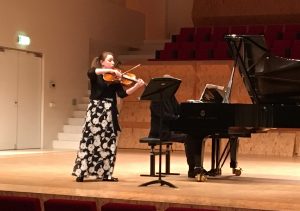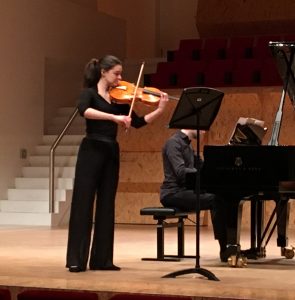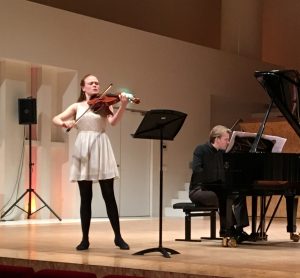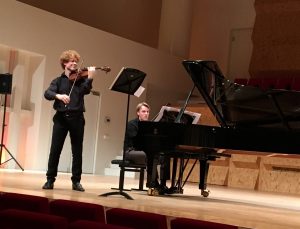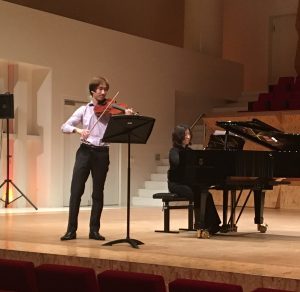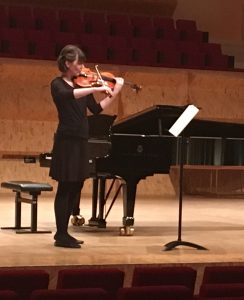door Kristofer G. Skaug
English version below! Follow this link.
We zitten in de Haitinkzaal van het Conservatorium voor de tweede ronde van het Nationaal Altvioolconcours. Er heerst opwinding onder de meegekomen fans van de acht geselecteerde halve finalisten.
Evgeniya Peschanskaya speelt de sonate in c kl.t. van Röntgen. Een van mijn favoriete altvioolsonates. Het eerste deel zit vol temperament. Het 2e deel heeft die mooie kenmerkende melancholische Röntgen-sfeer. Totdat er opeens een mooi recitatief in C groot komt. Een en al grote liefde die opbloeit.
Helaas hapert de linkerhand in het laatste en beslissende klimmetje – jammer. Het gekke bitonale scherzo gaat weer prima, en in het vierde deel komt de passie terug uit het eerste deel. Er had wel wat mij betreft wat meer klank geproduceerd mogen worden bij de hoogtepunten.
Nu komt de solosonate van Hindemith, op. 31.4, met het eerste deel dat in lange passages leunt op arpeggios met resonanties rondom de open A- en D-snaar. In allerlei opzichten een hele atletische toer voor links. Hier kampt ze wel met de intonatie, waardoor de beoogde resonantie soms wegvalt. Ze vecht zich dapper door tot het einde.
Hessel Moeselaar komt op, en speelt het Cadenza van Penderecki met heel veel energie en ook ingetogenheid. Hier en daar is de klank wat ruw, maar de concentratie is intens. Hij schrikt wakker van het enthousiaste applaus. De sonate van Badings is een mooi stuk en wordt niet vaak gehoord. In het eerste deel zit een triomfantelijk openingsthema. Hierna lijkt Hessel iets minder goed voorbereid, onzeker van de richting. Bij de inzet van de reprise komt het weer goed. Dit goede gevoel neemt hij mee naar het lyrische 2e deel, dat erg mooi wordt gebracht. Via een scherzo-achtige beweging sluit hij af met veel stormachtigheid in een landschap dat lijkt op het begindeel. Goed gespeeld!
Martin Moriarty speelt delen uit de Britten solo cellosuites. Deze bewerking door Nobuko Imai biedt spannend nieuw materiaal voor altviolisten. De uitvoering is ook heel spannend. Het laatste deel “Moto Perpetuo e Canto Quarto” valt op. In de daaropvolgende sonate van Bax heeft het 1e deel een heel mooi lied als hoofdthema. Ik heb wel het idee dat Martin hier meer had kunnen doen met klank. Technisch valt er niets te klagen, hij heeft het goed op een rijtje. Het 2e deel heeft een heel catchy thema gebouwd op een onheilspellende “Jaws”-achtige piano ostinato. De lichaamstaal van deze man moet ook genoemd worden. Hij staat regelmatig gespannen als en veer, en is niet wars van dramatische bewegingen. Het oogt als een authentiek gevoel, maar hier en daar slaat het wel door in zijn klank, niet altijd op de wenselijke manier. Wel een boeiende speler!
Lara Albesano opent met de 1e sonate van Martinu. Ze heeft een hele mooie klank en een rustige uitstraling. Ook in het tweede deel, waar de muzikale vlam in de pan slaat, houdt ze haar hoofd koel. Goed verzorgd spel, maar ik mis wel een beetje Roemeense vurigheid – die komt nu voornamelijk van de hollander achter de toetsen (Daniël Kramer), die overigens een pittige klus heeft hier. En dan, Hindemith’s mooie opus 25.1. De fraseringen in het eerste deel slaan voor mijn gevoel een aantal mooie kansen over. Het ingetogen 3e deel heeft een mooie sfeer. Vervolgens gaat ze in een verbijsterend tempo door het beruchte 4e deel (met bijschrift “Tonschönheid ist Nebensache”) heenrazen, daar is de adrenaline wel aan het gieren. Het troostrijke laatste deel (met naweeën van pijn) brengt ze heel mooi.
Na de lunchpauze zijn we klaar voor Lotus de Vries: ook zij speelt Martinu. Haar presentatie is een stuk minder volkomen dan die van Lara, maar het is daartegenover wel spannender. Als solostuk heeft ze de 1e suite van Reger gekozen. Hier word ik herinnerd aan het lastige van deze ronde: Hoe vergelijk je zo’n Reger met de Hindemiths, de Penderecki en de Britten van daarnet? Het is een heel andere muziek. Qua diepgang in mijn beleving is de compositie ook minder interessant, het heeft meer weg van een lyrisch uit de hand gelopen etude. Wel goed gedaan, daar niet van.
William “Billy” Murray speelt exact hetzelfde programma als Lara, maar dan in omgekeerde volgorde: Beginnend met Hindemith op. 25.1. Hij heeft duidelijk talloze keren dit stuk al uit zijn hoofd gespeeld, want hij neemt het niet meer zo nauw met wat er feitelijk op papier staat, vooral qua rytmiek is het soms erg vrij. Hij vertrouwt volledig op zijn Amati, dat er hoe dan ook altijd iets moois uit komt. En schrikt zichtbaar, wanneer dat per ongeluk toch niet het geval is.
Het is al met al slordiger dan de renditie van Lara, en ook minder virtuoos (een langzamer 4e deel), maar nooit saai. Hij geniet van de klank en de ruimte, en maakt er een diep persoonlijke vertolking van. Daarna speelt hij de Martinu sonate. Ook dit is bij lange na niet technisch perfect, maar je kunt er enorm van genieten vanwege het plezier waarmee de man staat te spelen. Hij weet heel goed waar de muziek over gaat. Hij neemt bescheiden twee stapjes terug als in het tweede deel de piano een solopartij heeft, en mompelt binnensmonds de pianostem mee. En hij is honderd prosent aanwezig, tot de laatste noot.
De volgende is Take Konoye. Hij begint met Reger suite no.1. Ik impliceerde net al dat ik dit niet zo’n interessant stuk vind, maar hij maakt het wel boeiend, hij ziet kansen om profielen te maken met klank en frasering, en benut deze kansen ook helemaal. En met bijna perfecte intonatie en stokbeheersing. Een hoogstandje! Hij vervolgt met de Bax-sonate. Heel muzikaal en technisch secuur. Ik heb maar één gemis, ik zou hem eens een keer helemaal los willen zien gaan. Risico durven nemen om een nòg grotere klank en nòg meer passie in het spel te leggen. Omdat die dus overduidelijk al zoveel kan. Maar dat is wel heel veel gevraagd op een concours, waar een finaleplaats op het spel staat.
Als laatste in deze ronde speelt Hannah Shaw. De solosonate van Ligeti. Hier komt in de Hora Lunga toch een hoop klank bovendrijven! Op een gegeven moment stijgt die op naar de eeuwige harsvelden via micrometerwerk op natuurtoon flageoletten. Knap. In het 2e deel (“Loop“) allerlei dissonante akkoorden, een kippenhok. Ben geen kenner van deze sonate, dus ik bewaar mijn oordeel voor een andere keer. Ze gaat verder met de Bax-sonate. Gisteren had ze een felgekleurde shirt aan bij een kleurarme Enescu, vandaag staat ze in het zwart maar is haar muziek een stuk kleurrijker. Toeval? De klank is mooi verzorgd, misschien wel tè mooi. Ook haar zou ik meer durf toewensen. Zelfs in de opwindende versnelling aan het eind van het 2e deel laat ze zich niet helemaal gaan.
Wie van deze 8 spelen zondag in de finale? De keus van de jury is voor mij geen verrassing: Martin, Billy en Take.
~~~~~~~~~~~~~~~~~~~~~~~~~~~~~~~~~~~~~~~~~~~~
English Version:
We are seated in the Haitinkzaal of the CvA for the 2nd round of the National Viola Competition. There is a buzz of excitement among the fans of the eight selected semifinalists.
Evgeniya Peschanskaya plays the C minor sonata by Röntgen. This is one of my favourite viola sonatas. The first movement is full of temperament. The second movement has this beautiful melancholic atmosphere typical of Röntgen. And then a wonderful recitativo in C major appears, blossoming love! Unfortunately her left hand falters in the final and decisive climb to the high note, a pity! The weird bitonal scherzo works fine, and the fourth movement sees the return of the passion from the first movement. I had hoped for a bit more sound production around the various climaxes in this piece.
Next she plays the solo sonata op. 31.4 by Hindemith, with a first movement that for a large part consists of double-stop arpeggios with resonances on the open A- and D-strings. This is a big athletic feat for the left hand, but she is struggling a bit with the intonation, and as a result the intended resonances are sometimes not heard. She bravely fights her way to the finish.
The next candidate is Hessel Moeselaar, he plays the Penderecki Cadenza with alternations of outward energy and silent introspection. Here and there there are some rough spots in the sound, but his concentration is intense. He is jerked awake by the enthousiastic applause. The Badings sonata is very beautiful and yet not often heard. The first movement has a triumphant opening theme. After this introductory section however, Hessel seems a bit unsure of his direction. At the recapitulation of the main theme, he recovers. He takes the feeling of relief with him into the more lyric opening of the 2nd movement, which is very pleasing. There is a scherzo-like section that brings us to a tempestuous closure of the sonata, with a landscape reminiscent of the first movement. Well played!
Martin Moriarty plays the 1st cello suite by Britten. This transcription by Nobuko Imai offers interesting new repertoire for violists. His performance is also very enjoyable. The last movement “Moto Perpetuo e Canto Quarto” particularly triggers my interest. The subsequent Bax viola sonata has a very beautiful opening theme, an English folk song. In my view, Martin could have achieved more variety of tone production here. In the technical sense there is not much to complain about, he has got the stuff well sorted out. The second movement has a very catchy and energetic dancing theme, which floats on top of an ominous “Jaws”-like ostinato in the piano. I also need to mention the body language of this man. He regularly stands like a compressed spring, and he does not shy away from dramatic movements. It looks emotionally authentic to me, but now and then it undeniably affect his playing, in a negative sense. But this is by all means a fascinating player!
Lara Albesano starts with the 1st Martinu sonata. She has a very beautiful sound and a calm appearance on stage. Also in the second movement, where musical fireworks take place, she keeps her head cool. Her playing is carefully curated, but I do miss a bit of Rumanian temper – which is now supplied mostly by the Dutch guy at the piano (Daniël Kramer), who by the way has his hands full with this piece. And then, Hindemith’s beautiful opus 25.1 (solo sonata). Her phrasing in the 1st movement misses a number of nice musical opportunities, in my view. Her rendition of the calm 3rd movement hits the right mood. And she goes on to play the infamous 4th movement (with the subtitle “Tonschönheid ist Nebensache”) at a ferocious speed, which gets the adrenaline flowing for sure. The soothing last movement (with echoes of pain) is performed very beautifully.
After a short lunch break we are ready for Lotus de Vries: she, too, plays Martinu. Her rendition is quite a bit less perfect than Lara’s, but is on the other hand more musically interesting. Her chose solo piece is the 1st Reger suite. At this point I am forced to consider a difficulty for the jury in this round: How do you compare such a Reger with the Hindemiths, the Penderecki and the Britten solo pieces? This is a very different music. I feel much less depth in this composition, it seems more like an etude that got out of hand. Don’t get me wrong, she plays it very well.
William “Billy” Murray plays exactly the same programme as Lara before, but in the opposite order, starting with Hindemith op. 25.1. He has clearly played this piece by heart countless times already, because he’s not so preoccupied with what is actually written on paper. Especially his rhythmic reading is at times very free. Furthermore he completely trust his Amati that it will produce something beautiful regardless, and he is visibly jolted when this charm fails to work. His Hindemith is overall less perfect than Lara’s, and also less virtuosic (a slower pace in the 4th movement), but it is never dull. He enjoys the sounds and the space he’s in, and produces a deeply personal interpretation. Subsequently he plays the Martinu. This, too, is far from technically perfect, but it is very enjoyable due to the sheer pleasure with which this man is playing. He knows very well what the music is all about. He modestly takes two steps back when there’s a solo for the pianist, all the while however silently mouthing the piano’s musical words. And he is one hundred percent present in the music, until the very last note.
The next candidate is Take Konoye. He starts with the Reger solo suite no.1. I was implying just then that this piece doesn’t interest me so much. But he manages to make it interesting, spotting and using opportunities to create extra profiles with sound and phrasings. And he has an almost perfect intonation and bow control. A masterpiece! He follows up with the Bax sonata, very musical and technically robust. I really have only one want: I would like to see him play with more abandon, daring to take some risks in search of an even bigger sound and even more passion in his playing. Just because he obviously already masters so much. But I fully realize that this is a lot to ask in a competition, with a spot in the final round at stake.
The last turn in this semifinal goes to Hannah Shaw, with the Ligeti sonata (two movements). Finally, here she generates a lot of sound in the Hora Lunga! At a certain point the music ascends to the very highest pitches where left-hand fingers are probing their way in resolutions of micrometers to find the right natural flageolets. Well done! In the 2nd movement (“Loop“) we hear all sorts of dissonant chords, it gets quite chaotic. I’m not very familiar with this piece so I will reserve my judgement for another time. She continues with the Bax sonata. Yesterday she played a blandish Enescu in a very brightly coloured shirt, but today she plays a colourful Bax, dressed in black. Can it be a coincidence? Her sound is very clean and pure, perhaps too pure. For her, too, I would wish a bit more “guts”. Even in the exciting acceleration at the close of the 2nd movement, she doesn’t let herself go entirely.
Which of these 8 will play in the final on Sunday? The jury’s choice is not a big surprise for me: Martin, Billy and Take.

